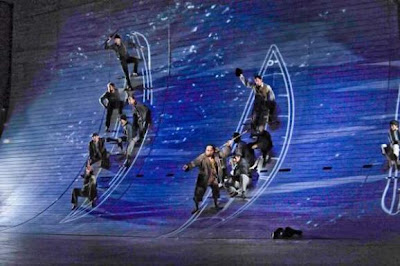We have reviewed our last concert of 2013, which means it is time to take stock of the year that was. The following is a list of the Top Ten live performances I reviewed this year, listed in chronological order. We conclude with a few other year-end honors (and dishonors) in several categories, as well as a remembrance of the notable people we lost this year.
BEST CONCERTS
1. Daniil Trifonov (Kennedy Center Terrace Theater, January 19)
Trifonov began Liszt's B minor piano sonata with an air of mystery, a murky opening with the initial notes of the descending motif made to ring, with the following notes slipping underneath it. When the piece took off, Trifonov raced through it, giving the sense of a soul tormented, wracked by terror, driven toward the exalted major-mode rising theme, played with relieved abandon. The slow passages were lost in rhapsody, with no need to rush through them, as Trifonov explored each whorl and curl of thought, while the fugue, which came out of nowhere, was drenched in sweat.
2. Anne Sofie von Otter (Kennedy Center Terrace Theater, March 4)
Once in a very rare while, I hear a concert that attains that crucial combination of diverting programming performed to an impeccable standard by musicians who seem perfectly matched to the music they are performing. This recital by mezzo-soprano Anne Sofie von Otter and pianist Bengt Forsberg, offered by the Fortas Chamber Music series in the context of the Kennedy Center's Nordic Cool festival in the Terrace Theater (both artists are Swedish), was in that category.
3. Bellini, Norma (Washington National Opera, March 9 to 24)
Soprano Angela Meade was a knockout in the title role, which she is singing on stage for the first time. It was not a standout because she was the most powerful Norma or the one with the strongest high notes, nor did she give the character the same kind of dramatic edge as some other more famous Normas. Meade deployed her velvety voice to give a truly beautiful finish to this mother of all bel canto roles, with a suave, hypnotic Casta diva, for example. There was power in Meade's voice, too, allowing her to soar over the orchestra and to stand her ground with the much more experienced and frankly just louder Adalgisa of Dolora Zajick, but it was the elegance of the performance that remains with me, both in Meade's calm presence and in the cleanness and warmth of her tone.
4. Christophe Rousset (La Maison Française and Library of Congress, April 12 and 13)
The three suites that filled out the program, played without intermission, each ended with a “tombeau,” a musical tribute by one composer to another composer who has just died, like a sculpted portrait placed upon a tomb. To the dances of Johann Jakob Froberger’s 19th suite, Rousset appended Froberger’s tombeau for the lutenist Charles Fleury de Blancrocher. This cerebral piece ended with a crashing minor scale down the bass keys, a reference to Blancrocher’s death after falling down a flight of stairs, where he died in the arms of his best friend, Froberger.
5. Staatskapelle Dresden (Strathmore, April 16)
The Brahms fourth symphony, opening with that distinctive main theme, had a gentle tidal pull, no heaving, nothing overwrought, some surges -- especially at the end of the first movement -- but also real delicacy of emotion. The violin section's beautiful sound was meted out carefully, never allowed to overwhelm other parts that were more important. The second movement did not become overly sentimental, emotional pain buried deep inside, followed by a boisterous third movement, enlivened by a somewhat unpredictable approach to the tempo at the podium. The finale had serious zip to it, with Thielemann not giving us a chance to breathe until the section with that lovely flute solo, slowing down to an even more solemn pace for the trombone-heavy section, after which the performance exploded into action again.













.jpg)





















































